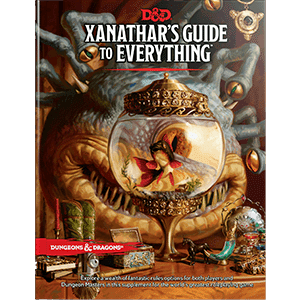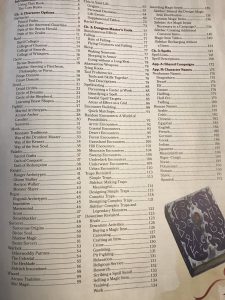Xanathar’s many eyes have seen (and disintegrated) many things during his lifetime, and it turns out that when the Beholder is not crime-lording, he’s journaling–or at least collecting all kinds of data from across D&D’s Forgotten Realms.
The Beholder has done us a mighty favor by curating all kinds of knowledge into a single volume: Xanathar’s Guide to Everything. In this tome, he details several new curious and powerful beings (subclasses), dozens of wondrous and unfamiliar magics (spells), and offers explanations for how the world works (rules and tools).
A Review of Xanathar’s Guide to Everything
 Let’s get straight into the review of Xanathar’s Guide. Can it really deliver everything?
Let’s get straight into the review of Xanathar’s Guide. Can it really deliver everything?
The subclasses add some much-needed variety to PCs. D&D 5e is woefully behind Paizo’s Pathfinder when it comes to race/class/subclass combos and sheer variety. D&D makes up some of that ground with Xanathar’s; providing some excellent subclasses to play around with, all of which are AL (Adventurer’s League) legal.
I’ve never wanted to play a Cleric before, but the Forge Domain might actually have me anxiously awaiting the death of my next PC so I can give it a go. And a College of Swords Bard seems awesome, too! Each of the Player’s Handbook (PHB) classes get sweet new options in Xanathar’s. I guarantee you’ll find one that excites you.
The rules and tool section also brings some depth to your campaign. Most of the time when I read rules for a game, it feels like a bit of a necessary evil before the fun bits. Xanathar’s Dungeon Master Tools section changed all that. I can honestly say I’ve never read a section on rules and tools that I wanted to implement more quickly and eagerly than I found in this book.
Downtime, tool proficiencies, traps, spell casting, magic items and more get some refinement and expansion. More than just providing more tables to roll on, the team behind Xanathar’s spends some time getting you to think about their uses:
- How do you tailor random encounters to your party and adventure?
- When is the awarding of a magic item appropriate? How often? How powerful?
- What kind of trap should you use?
There’s stuff here for both the greenhorn DM and one who has been rolling dice behind a screen for 30 years.
More spells are always better! I personally don’t think 5e was lacking in the spells department (however I don’t often play a caster, so take that with a grain of salt), but more can’t possibly hurt! And there are some truly awesome spells for each caster class added into the mix in Xanathar’s.
Like the subclasses, many are familiar additions if you’ve been keeping tabs on UA (Unearthed Arcana, the downloadable supplements Wizards of the Coast used to playtest the new Xanathar material), but some are making their debut as best I can tell.

Xanathar’s Guide to Everything: A Short Defense

Ever since a pic of the table of contents was shared online, the community has run hot and cold on Xanathar’s. The vast majority of the wet blankets came as a result of the last 20ish pages which consist of nothing but lists of names.
And I get that. Make that list a free PDF on DMsGuild.com or leave it to one of the hundreds of free online fantasy name generators. But…
The folks behind 5e (Mike Mearls and Jeremy Crawford, in particular) are working overtime to make entrance into and participation within this awesome Dungeons and Dragons community as easy as possible for the uninitiated. Xanathar’s Guide to Everything has several tools specifically designed and included to pursue that end–including but not limited to the list of names.
I love, too, the inclusion of the three backstory aids for each class. Before getting to the new subclasses and their mechanics, Xanathar’s pauses to say, “Hey, lets build out your character’s narrative a bit first. Have you considered what superstitions your Barbarian has? What about a secret your Cleric is hiding? Or a treasured item for your Druid?”
And each of these comes with a table that allows you to roll a d6 if you’re not exactly the creative type. There’s even an entire section devoted to filling out the details of your character’s life (also with tables) like Birthplace, Family, and Life Events. Again, all included for one of three groups of players:
- The newbie who has never done it before.
- The veteran player who struggles with creativity.
- Any player who wishes to have a defined backstory quick, fast, and in a hurry.
That is a tremendous strength of Xanathar’s Guide to Everything and should not be held against it. Just because you might not need the inspiration for your backstory or a pre-generated name doesn’t mean it was a poor addition to the book. The names were not a “filler” addition. They jive with the goal of Wizards of the Coast and the Dungeons and Dragons team 100% and dovetail perfectly with the other aids within the book. All the content fits, it makes sense.
Xanathar’s Guide to Everything should be the second book any newcomer to our community purchases; right behind the PHB.
Xanathar’s Guide to Everything: A Worthy Addition
Some folks will balk at the $50 cover price given that it only has about 20 pages more than the Sword Coast Adventurer’s Guide (whose cover price was only $39.95), but I’d argue that Xanathar’s provides a lot more than those 20 extra pages imply.
It is a book with boons for both the player and the dungeon master, and is an excellent embodiment of the Dungeons and Dragons team’s core values. It is a product, but it is also a statement:
We want you to play D&D and we’re willing to make it increasingly easy and fun to plug in to our community.
Nailed it.
[Disclosure: Wizards of the Coast provided Nerds on Earth a copy of Xanathar’s Guide to Everything for review.]

